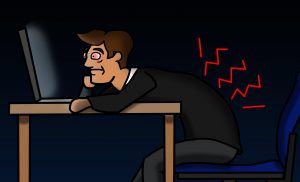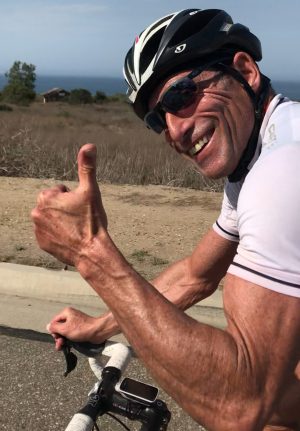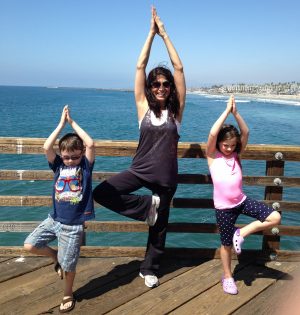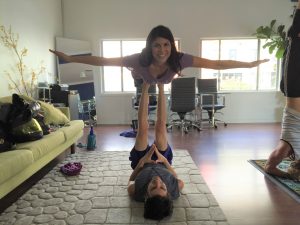
Illustration by Ethan Williams.
Have you checked your step count recently? Be real, is it under 4,000? That’s understandable. You’re at home lounging on your couch or bed. You’ve basically had a free pass to be lazy this past year. But at what cost?
Have you even thought about what this state of physical inactivity has been doing to your body? Or maybe you just don’t care? Either way, you should probably consider making some changes to your daily routine, what with the transition to normal life approaching.
Students have indeed admitted to being less active this year, due in part to the sheer structure of online classes.
Joy Joukhadar, a sophomore sociology, political science, and English major, has been living through this struggle.
“I’ve never been this inactive in my life. Sometimes I take an extra walk to the fridge just to feel like I got more steps in,” said Joukhadar.

Photo courtesy of Joy Joukhadar.
The fridge is a step in the right direction, but the ultimate goal is to actually make it past the fridge and out the door.
“I barely have the time to fit in any workouts or walks in between classes. The most I can do for my fitness is walk my dog before class sometimes.”
Being online really takes a toll on the students’ postures too. Joukhadar sits on Zoom in a hunched position and barely has time to crack her back in between classes.
“Three semesters online means I probably need to start looking for a chiropractor,” said Joukhadar.
Right now, assuming you’re one of the many who have been taking advantage of Quarantine Laziness™, your body is internally cursing at you. Maybe you’re generally not an active person. That’s okay! No shame there. But there’s no denying that staying at home all day for a year has made you even less active than before. Now we’re treading into dangerous territory.
Prior to COVID-19, even the least active person would get some semblance of movement in their day just by doing their daily activities like walking to classes, doing grocery shopping, going out with friends, and so on.
Students, while now at home majority of the time, are sitting more throughout the day than they used to. Associate

Photo courtesy of Eric Sternlicht.
Professor of Health Sciences Dr. Eric Sternlicht attributes this new inactive lifestyle to the stay-at-home orders.
“When students are in a classroom, of course they’re sitting for 50 minutes, but if you have a class in Argyros, and a class in DeMille Hall, or a class over in Dodge, you’re definitely getting some activity while you’re walking from class to class,” said Sternlicht.
Zoom is clearly not an ideal mode of instruction for most people. According to Life Coach and Yoga Instructor Sharleen Bazeghi, it can have negative implications on overall health.
“Zoom fatigue is real. People’s faces are much closer up on a Zoom screen than we see in real life, so it’s fatiguing to feel so invaded all the time,” said Bazeghi. “There’s physical, mental, and emotional factors that go into this. It definitely is wearing on the body and your ability to focus.”
Joukhadar reflects on her inactivity and wants to get back out there after COVID.
“Being at home and taking classes from my bed has really eliminated any need to be active. Being home has definitely ruined any semblance of motivation,” said Joukhadar. “All I want to do after the pandemic is get out–go hiking, beach days, swimming with friends. I never needed a workout routine because I was active enough with friends, and I want to go back to that.”
In some cases, like that of sophomore applied human physiology major Itzel Moncayo, COVID-19 has provided ample opportunity to increase physical activity levels.
“Because of the pandemic, I haven’t been leaving my house as much, so I was able to stick to a more structured schedule that allowed me to make time for exercise,” said Moncayo.

Photo courtesy of Itzel Moncayo.
Moncayo is a dancer who took the extra time to work out, but is no stranger to the mental health struggles that came along with quarantine life.
“Because I’ve stayed home for so long, motivation and mental health have fluctuated a lot more than it did pre-COVID, which can sometimes affect the level of physical activity I do,” said Moncayo.
While Moncayo has days where she feels less motivated, she is overall content with her physical activity at the moment and hopes to keep it up after the COVID-19 situation eases up.
In addition to reduced physical activity levels amongst most people, the temptation to eat junk food and order take out has also been very high.
“This stay at home order has really restricted the involvement of individuals in exercise. There has been an enormous amount of lives lost due to COVID, and there has been an increase in weight gain. It really is a fact of eating and activity for optimal weight and weight gain,” said Sternlicht.
I hate to be the bearer of bad news, but according to Sternlicht, obesity rates are up by about 42.4%.
“When people aren’t moving around and they’re eating more processed foods, those unhealthy foods lead to chronic diseases which, aside from COVID, are the leading killers in our society,” said Sternlicht. “Those people that want to support local restaurants and businesses can only do so generally by take out.”

Photo courtesy of Sharleen Bazeghi
Bazeghi agrees that people find it easier to have bad eating habits when they’re already in a state of inactivity.
“We tend to eat better when we work out. When we don’t work out, that’s when we eat poorly as well. When you’re lazy, it all just perpetuates with feeling sluggish and eating out all the time,” said Bazeghi.
This truly is a bad combination. Not only are you being deprived of the benefits of physical activity, but its effects are actually exacerbated by eating junk food.
Sternlicht highlights some potential health risks that can develop from continuation of this lifestyle.
“There’s a link between Type 2 diabetes and sedentary lifestyle and obesity, a link between cardiovascular disease, certain forms of cancer, hypertension, and stroke. So all of these are related to activity, with a much greater impact being diet,” said Sternlicht.
Alright, so now that I’ve hopefully scared you a bit, what should you do about it? Well, Bazeghi always recommends that her clients start small to gradually build their stamina.

Photo courtesy of Sharleen Bazeghi.
“When you’re coming from an inert state of nothing, it takes so much energy to get going and you don’t get anything back right away, you’re only giving,” said Bazeghi. “Break down something dreadful into ten minutes of walking, five jumping jacks, whatever you want to focus on.”
When you start with high expectations, it becomes overwhelming and you may feel defeated right away, so the mere act of starting is an accomplishment in and of itself.
“We tend to be very goal oriented so we need that satisfaction of checking it off a list. Not only do you feel accomplished, but you get feedback with endorphins,” said Bazeghi.
Megan Miller is a junior journalism major and documentary film minor who, too, found it difficult to exercise during COVID-19.
“Honestly, I wasn’t a very physically active person before COVID. I’m also a very routine-oriented person, so when COVID happened and all of our normal routines flew out the window, I found it hard to get out of bed sometimes, much less exercise and get my body moving,” said Miller.

Photo courtesy of Megan Miller.
Back in January, Miller sustained an injury of compression fractures in three of the vertebrae in her lumbar spine. While going through recovery, Miller had to balance both her physical and mental health.
“This was honestly one of the weirdest injury recoveries I’ve had. The doctor strictly told me no exercise at all for three months, and I had to wear a big bulky back brace all day every day, except when sleeping or showering,” said Miller.
For the sake of her mental well-being, Miller had to disregard the doctor’s orders at times by going for occasional walks.
Miller feared that her injury might have left her paralyzed for the rest of her life and was afraid of what she would miss out on.
“All I could think of were the hikes I always wanted to do, but never got to, and all of the places I wanted to take my dog but might not be able to,” said Miller.
Miller’s injury amended her outlook on physical activity and gave her a newfound appreciation of staying healthy.

Photo courtesy of Megan Miller.
“I’m not paralyzed, thankfully, and now that my fractures have healed I’ve started exercising again to make sure any complications from my injury, or from my three months of inactivity, don’t happen,” said Miller.
If that’s not inspiration to get back to being active, I don’t know what is. Take advantage of moving around while you still can.
Taking walks is the best way to ease into it. Walk around your neighborhood, in the great outdoors, to your favorite places. Yes, that means you can (and should) get some steps in at the mall! To quote a classic saying that we’ve all probably seen planted on a Forever 21 shirt, shopping is cardio!

